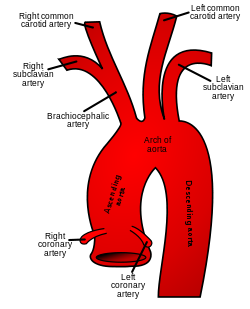Hi Pacerron and others,
I haven't seen the TV clip you're referring to, but this sounds suspiciously like a case where the media is spreading some disinformation. This is not a case of Europe doing something that hasn't caught on in the US yet. In almost every person in the general population, you don't need to take BP in both arms because small variations are completely normal. In a patient with severe atherosclerosis it is prudent to check BP's in each arm for reasons I'll explain below.
Some background that everyone should understand. This thread title refers to heart disease, but atherosclerosis affects all the blood vessels. In the heart, the most severe ultimate consequence is a heart attack (MI or myocardial infarction), in the brain -- stroke, in the kidneys -- hypertension and chronic renal failure, etc. No, I'm not going to talk about calcified plaques vs ulcerated plaques. I'm just going to tell you some basic "plumbing" and how it relates to pathophysiology.
The large artery coming out of your heart is called the aorta. It curves around and makes a U turn, called the aortic arch. Lower down, the aorta gives off branches to major organs in the abdomen. At the top of the aortic arch, there are 3 major branches that go to your neck/brain and arms: the brachiocephalic artery (aka innominate art.), left common carotid artery, and left subclavian artery. See attached pic.

Atherosclerotic plaque formation has a preference for the artery origins (branch points). The left subclavian artery artery for some reason gets more plaque than the other 2 in the arch. If there is enough plaque buildup, or narrowing, the blood pressure beyond that point will be lower. This is the main reason why there is sometimes a significant difference between the BP's in each arm. Very, very *basic* pathophysiology, which every primary care doc also understands. If the narrowing is severe enough, you don't just have a blood pressure differential: when you exercise your left arm, blood can be stolen from the other side via vertebral arteries which supply your brain, causing dizziness, fainting, or even strokes. One of 4 of the main arteries starts flowing backward (AKA subclavian steal syndrome) all because of narrowing of the artery supplying your L arm!
These are disease processes I work with every day. Today, I interpreted many chest CT scans and carotid ultrasounds, both of which we can use to diagnose subclavian stenosis. I can also "alleviate" these diseases, for instance, by opening a clogged up renal (kidney) artery with a stent to relieve life threatening severe HTN (only IF that is the cause of the high BP).
What I am trying to emphasize from a medical perspective, is that just looking at heart disease or micromanaging your cholesterol levels is not looking at the whole picture. Having heart disease just shows you have whole body atherosclerosis. Again, diet, exercise, stopping smoking, reduced stress (via faith, meditation, whatever works for you) are key. Much better than taking drugs. So, so many diseases that affect Western society, especially the USA could be markedly reduced.
Marcus Bryner, M.D.
Interventional & general radiologist

